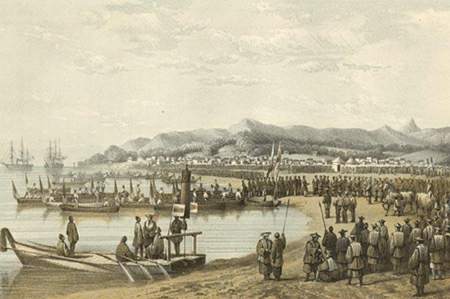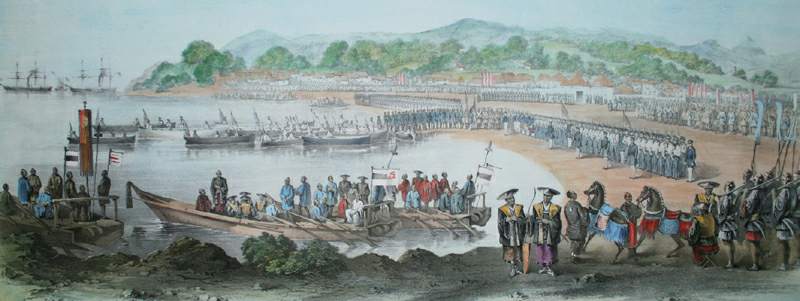|

 W. HEINE DEL -- E. BROWN Jr. DIREX -- SARONY AND CO LITH, N.Y. Type: Hand colored chromolithograph
Major Scene in the lithograph. Perry's squadron of four ships arrived at Yedo Bay on July 7, 1853 and anchored off the city of Uraga. On this first visit to Japan, Perry's primary mission was to deliver the President's letter to the Emperor of Japan. This lithograph depicts Perry's landing in Japan on July 14, 1853 to deliver the President's letter. The abridged narrative states:
The guides in the Japanese boats pointed to the landing place toward the centre of the curved shore, where a temporary wharf had been built out from the beach by means of bags of sand and straw. The advance boat soon touched the spot, and Captain Buchanan, who commanded the party, sprang ashore, being the first of the Americans who landed in the Kingdom of Japan. He was immediately followed by Major Zeilin, of the marines. The rest of the boats now pulled in and disembarked their respective loads. The marines (one hundred) marched up the wharf, and formed into line on either side, facing the sea; then came the hundred sailors, who were also ranged in rank and file as they advanced, while the two bands brought up the rear. The whole number of Americans, including sailors, marines, musicians, and officers, amounted to nearly three hundred; no very formidable array, but still quite enough for a peaceful occasion, and composed of very vigorous, able-bodied men, who contrasted strongly with the smaller and more effeminate-looking Japanese. These latter had mustered in great force, the amount of which the governor of Uraga stated to be five thousand; but, seemingly, they far outnumbered that. Their line extended around the whole circuit of the beach, from the further extremity of the village to the abrupt acclivity of the hill which bounded the bay on the northern side; while an immense number of the soldiers thronged in, behind and under cover of the cloth screens which stretched along the rear. The loose order of this Japanese army did not betoken any very great degree of discipline. The soldiers were tolerably well armed and equipped. Their uniform was very much like the ordinary Japanese dress. Their arms were swords, spears, and match-locks. Those in front were all infantry, archers and lancers; but large bodies of cavalry were seen behind, somewhat in the distance, as if held in reserve. The horses of these seemed of a fine breed, hardy, of good bottom, and brisk in action; and these troopers, with their rich caparisons, presented at least a showy cavalcade. Along the base of the rising ground which ascended behind the village, and entirely in the rear of the soldiers, was a large number of the inhabitants, among whom there was quite an assemblage of women, who gazed with intense curiosity, through the openings in the line of the military, upon the stranger visitors from another hemisphere. 
This lithograph may be available for purchase. To go to the lithograph price list, click here. |
|
The Perry Expedition: General Information : Related Books/Pubs The Lithographs: Characteristics : Condition : Listing : Buying Order On-line: Lithograph Price List : Book Price List ABE Book List: BaxleyBooks Inventory on ABE Special Interest Books/Art: ~ K. Ogawa - Color Collotypes and Books/Prints ~ T. Hasegawa - Color Woodblock Books ~ Shimbi Shoin - Art Reproduction Books ~ Tamamura/Takagi, Kobe - Color Collotype Books ~ Georges Bigot - Etchings & Art ~ Keisuke Serizawa - Calendar Folios & Art ~ Woodblock Printing - Process & Miscellaneous Books ~ Japanese Woodblock Prints ~ Blackie the Photographer - Okinawa Photo Essay Books Meiji Era - Japan Views & Images (Price Lists & Information): ~ Albumen Photos : Chromolithographs ~ Colored Albumen Photographs (from Brinkley Books) ~ Stereoviews : Kazumasa Ogawa Collotypes ~ CDV - K. Ogawa : CDV - Other : Cabinet Cards ~ Glass Slides, "Magic Lantern" - Hand Colored ~ Fujiya Hotel, Miyanoshita PayPal Accepted: Pay for Purchases with PayPal Buying Books: Our Book Buying Interests BaxleyStamps: Main Page : Ryukyu Stamps : Japan Stamps Copyright and Fair Use Policy is here.
|
|
If you have material to sell, please visit this page: Buying.
George C. Baxley
Perry Expedition to Japan Books & Lithographs |

